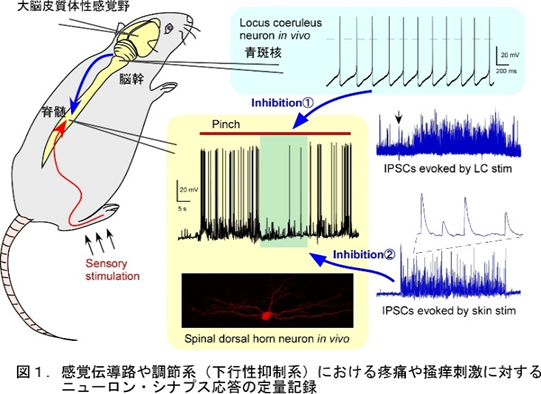Evaluating the efficacy of drugs against pain and pruritus and elucidating the neurophysiological mechanisms of analgesia and anti-itch
Information updated: July 31, 2023
- Seeds Information
- Researcher Information
- What do you expect from collaboration with companies?
- Contact for this research
Seeds Information
keyword
Pain, in vivo patch clamp, drug efficacy evaluation, emotion evaluation, itch
Field
pain
Overview
The in vivo patch clamp method, which we have developed in the past, is an extremely useful method for functional analysis at the single neuron and synapse level, such as the causes of behavioral abnormalities in pathological models and genetically engineered animals. It captures synaptic responses induced by physiological stimuli similar to those used in behavioral analysis, and allows for quantitative analysis of their amplitude and occurrence frequency, analysis of the effects of drugs administered systemically or locally, and recording and analysis of the behavior of neural circuits in real time when nerve nuclei are activated by Department of Genetics, etc. In particular, the so-called blind patch clamp method does not require visual confirmation of the recorded cells, so it has the advantage of being able to target not only nerve nuclei located on the surface of tissue but also mature animals where visualization is difficult due to the development of myelin, and model animals that require many days to prepare. It clearly evaluates drug efficacy and is useful for target exploration, and by integrative research combining behavioral Department of Pharmacology and analysis using slice preparations, we clarify the mechanism of action of analgesia and antipruritus. Another research theme is elucidation of the emotional central nervous system mechanisms such as the anterior cingulate gyrus. For details, please refer to the paper or our department's website.
What's new?
It is possible to record neural activity and synaptic responses in real time from in vivo specimens.
The blind method does not require visual confirmation of the recorded cells, and can be used to study mature animals that are difficult to visualize due to the development of nerve nuclei and myelin located not only on the tissue surface but also deep within, or model animals that require many days to prepare.
What are its advantages over other studies?
Using disease model animals, we can perform comprehensive analysis in combination with behavioral Department of Pharmacology, and immunohistological analyses.
Drugs can be administered intravenously to the whole body or locally, making it possible to clarify the details of the mechanism of action in behavioral Department of Pharmacology experiments.
What problem does it help solve?
This could lead to elucidation of the transmission and inhibition mechanisms of sensory information, particularly pain and itch, which are still largely unknown, as well as the efficacy evaluation of potential pharmaceutical drugs.
This could potentially lead to elucidation of diseases whose onset mechanisms are unknown, such as neuropathic pain, and to the identification of new drug discovery targets.
Possibility of other applications and developments
Emotional aspects can also be quantified as neural responses.
It can also be applied to the autonomic nervous system.
Related Patents
―
Related papers
- K Koga, K Kobayashi, M Tsuda, K Kubota, Y Kitano, H Furue. Voltage-gated calcium channel subunit α2δ-1 in spinal dorsal horn neurons contributes to aberrant excitatory synaptic transmission and mechanical hypersensitivity after peripheral nerve injury. Front Mol Neurosci, 2023, 16: 1099925
- T Tanioku, M Nishibata, Y Tokinaga, K Konno, M Watanabe, H Hemmi, Y Fukuda-Ohta, T Kaisho, H Furue, T Kawamata. Tmem45b is essential for inflammation- and tissue injury-induced mechanical pain hypersensitivity. Proc Natl Acad Sci USA 2022, 119(45):e2121989119
- Iwao Seki, Ayumi Nakamura, Keisuke Koga, Hiroyuki Aono, Hidemasa Furue. Effects of acetaminophen on neuronal activity in the mouse locus coeruleus. PAIN RESEARCH: 2022, Vol. 37, No. 1, pp. 16-25.
- Matsumoto Y, Fujino Y, Furue H. Anesthesia and surgery induce a functional decrease in excitatory synaptic transmission in prefrontal cortex neurons, and intraoperative administration of dexmedetomidine does not elicit the synaptic dysfunction.Biochem Biophys Res Commun. 2021;572:27-34.
- Funai Y, Pickering AE, Uta D, Nishikawa K, Mori T, Asada A, Imoto K and Furue H. Systemic dexmedetomidine augments inhibitory synaptic transmission in the superficial dorsal horn through activation of descending noradrenergic control: an in vivo patch-clamp analysis of analgesic mechanisms. Pain 2014, 155(3): 617-628.
- Furue Hidemasa. Descending control mechanisms: serotonin system, noradrenaline system. Journal of the Japanese Medical Association 143 Special Issue(1): 42-43, 2014
- Furue H. In vivo patch-calmp recording technique. In: Patch Clamp Techniques: From Beginning to Advanced Protocols. (Springer Protocols Handbooks), Springer-Verlag, pp.171-182, 2012
- Furue, Hidemasa. In vivo blind patch method. In:Latest patch clamp experimental techniques, Yoshioka Shoten (edited by Okada, Yasunobu), pp.115-120, 2011
- Furue H, Katafuchi T, Yoshimura M. In vivo patch. In:Patch-Clamp Analysis: Advanced Technique, Second Edition (Eds. Wolfgang Walz) The Humana Press Inc pp.229-251, 2007
- Furue, H., Sonohata, M., Yoshimura, M.. In vivo patch clamp recordings from dorsal horn cells in mouse and rat spinal cords. Japanese Journal Physiology 65(10):315-321, 2003
- Furue H, Narikawa K, Kumamoto E and Yoshimura M. Responsiveness of rat substantia gelatinosa neurons to mechanical but not thermal stimuli revealed by in vivo patch-clamp recording. J Physiol(Lond) 521:529-535, 1999
Researcher Information
| full name | Hidemasa Furue |
|---|---|
| Affiliation | Department Physiology and Neurophysiology, School of Medicine |
| Specialization | pain |
| Collaborative Researcher | Kohei Koga and Keisuke Koga |
| Related links | Laboratory website |
What do you expect from collaboration with companies?
Development and utilization of basic medicine through industry-academia collaboration
Collaborative research into the mechanism of action of pain medications
Elucidation of the neural mechanisms underlying the expression of pain and itch during pathological conditions, evaluation of the efficacy of candidate compounds on neural responses, comprehensive analysis linking the dissociation of drug concentration and dose in vitro and in vivo systems, elucidation of the neural mechanisms underlying behavioral abnormalities at the single neuron and synapse levels
Contact for this research
兵庫医科大学 大学事務部 研究推進課
E-mail: chizai@hyo-med.ac.jp
Tel: 0798-45-6488

 Research Seeds Collection
Research Seeds Collection
